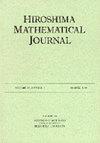同迹结的构造注释
IF 0.5
4区 数学
Q3 MATHEMATICS
引用次数: 3
摘要
结的$m$-迹是从$\mathbf{B}^4$获得的$4$-流形,方法是沿结连接一个带有$m$框架的$2$-柄。2015年,Abe、Jong、Luecke和Osoinach引入了一种技术,用相同的$$$-trace构造无限多个结,称为运算$[上百万]$。在本文中,我们证明了他们的技术可以用贡普夫和宫崎骏的可对偶图案来解释。此外,我们还表明,接受Teragaito提供的相同$4$-手术的结家族可以用手术$(\ast m)$来解释。本文章由计算机程序翻译,如有差异,请以英文原文为准。
Notes on constructions of knots with the same trace
The $m$-trace of a knot is the $4$-manifold obtained from $\mathbf{B}^4$ by attaching a $2$-handle along the knot with $m$-framing. In 2015, Abe, Jong, Luecke and Osoinach introduced a technique to construct infinitely many knots with the same $m$-trace, which is called the operation $(\ast m)$. In this paper, we prove that their technique can be explained in terms of Gompf and Miyazaki's dualizable pattern. In addition, we show that the family of knots admitting the same $4$-surgery given by Teragaito can be explained by the operation $(\ast m)$.
求助全文
通过发布文献求助,成功后即可免费获取论文全文。
去求助
来源期刊
CiteScore
0.60
自引率
0.00%
发文量
12
审稿时长
>12 weeks
期刊介绍:
Hiroshima Mathematical Journal (HMJ) is a continuation of Journal of Science of the Hiroshima University, Series A, Vol. 1 - 24 (1930 - 1960), and Journal of Science of the Hiroshima University, Series A - I , Vol. 25 - 34 (1961 - 1970).
Starting with Volume 4 (1974), each volume of HMJ consists of three numbers annually. This journal publishes original papers in pure and applied mathematics. HMJ is an (electronically) open access journal from Volume 36, Number 1.

 求助内容:
求助内容: 应助结果提醒方式:
应助结果提醒方式:


